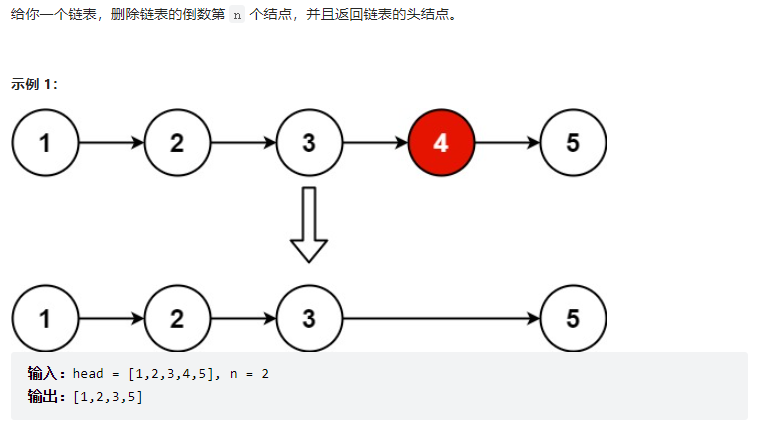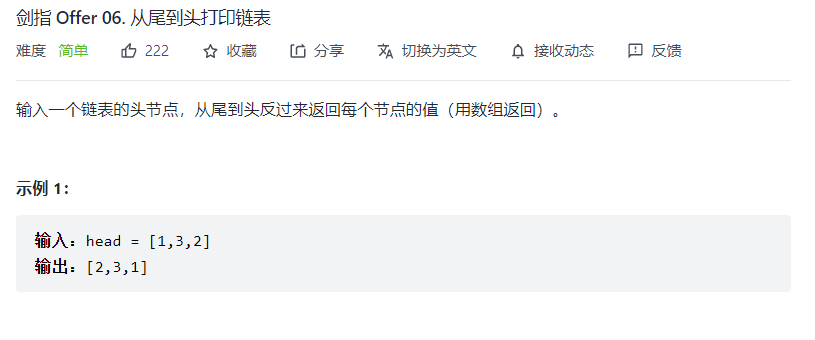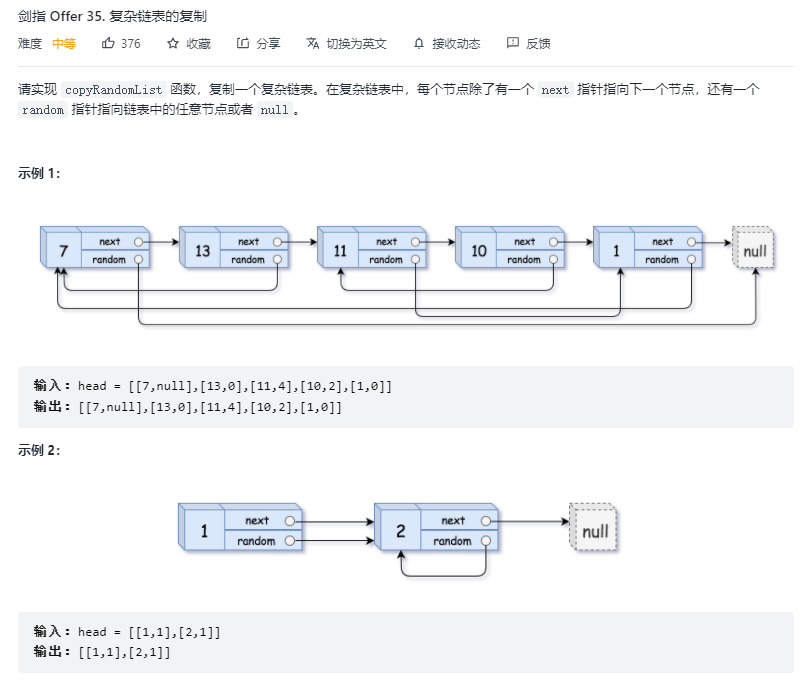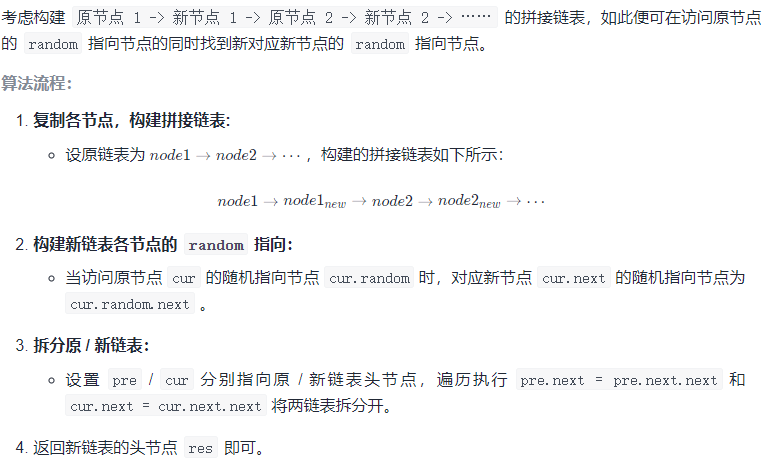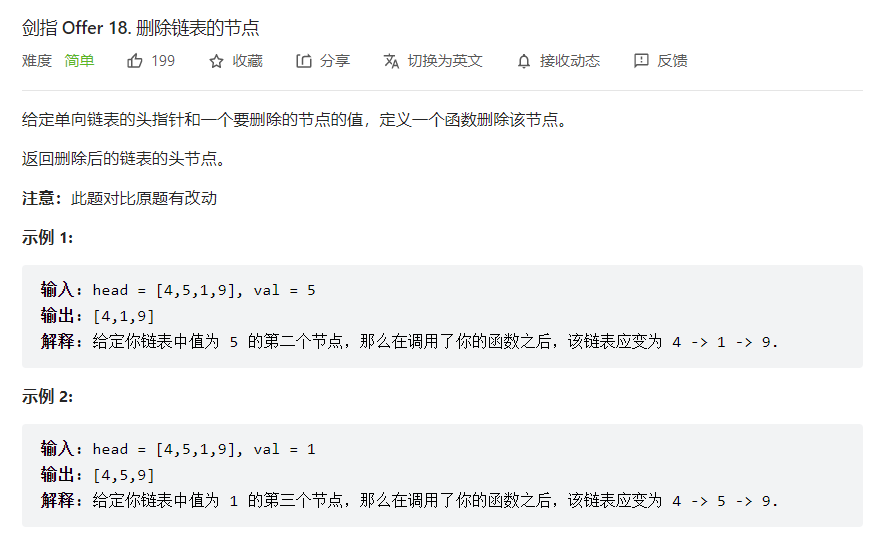反转链表
方法一:迭代
1 2 3 4 5 6 7 8 9 10 11 12 ListNode* reverseList (ListNode* head) { ListNode* prev=nullptr ; ListNode* curr=head; ListNode* cnext; while (curr!=nullptr ){ cnext=cnext->next; curr->next=prev; prev=curr; curr=cnext; } return prev; }
方法二:递归
1 2 3 4 5 6 7 8 9 ListNode* reverseList (ListNode* head) { if (!head || !head->next) { return head; } ListNode* newHead = reverseList (head->next); head->next->next = head; head->next = nullptr ; return newHead; }
求链表倒数第K个节点
方法一:快慢指针
1 2 3 4 5 6 7 8 9 10 11 12 ListNode* getKthFromEnd (ListNode* head, int k) { ListNode *fast=head; while (fast!=nullptr &&k>0 ){ fast=fast->next; k--; } while (fast!=nullptr ){ fast=fast->next; head=head->next; } return head; }
方法二:求出链表长度
1 2 3 4 5 6 7 8 9 10 11 12 13 14 ListNode* getKthFromEnd (ListNode* head, int k) { int n = 0 ; ListNode* node = nullptr ; for (node = head; node; node = node->next) { n++; } for (node = head; n > k; n--) { node = node->next; } return node; }
因为存在可能把头节点也给删除了,因此给当前链表新增一个头节点
1 2 3 4 5 6 7 8 9 10 11 12 13 14 15 16 17 18 19 20 21 class Solution {public : ListNode* removeNthFromEnd (ListNode* head, int n) { ListNode *newHead = new ListNode (); newHead->next = head; ListNode *fast=newHead; while (fast!=nullptr &&n>0 ){ fast=fast->next; n--; } ListNode* cur = newHead; while (fast->next!=nullptr ){ fast=fast->next; cur=cur->next; } cur->next = cur->next->next; return newHead->next; } };
两条链表的第一个公共节点
1 2 3 4 5 6 7 8 9 10 11 12 13 14 15 16 17 18 19 20 21 22 23 24 25 26 27 28 29 30 31 ListNode *getIntersectionNode (ListNode *headA, ListNode *headB) { ListNode* tmpA=headA;ListNode* tmpB=headB; int lenA=0 ;int lenB=0 ; while (tmpA!=nullptr ){ tmpA=tmpA->next; lenA++; } while (tmpB!=nullptr ){ tmpB=tmpB->next; lenB++; } tmpA=headA;tmpB=headB; if (lenA>lenB){ while (lenA!=lenB){ tmpA=tmpA->next; lenA--; } }else { while (lenB!=lenA){ tmpB=tmpB->next; lenB--; } } while (tmpA!=tmpB){ tmpA=tmpA->next; tmpB=tmpB->next; } return tmpA; }
判断链表是否有环
时间复杂度:O(N),其中 N 是链表中的节点数。当链表中不存在环时,快指针将先于慢指针到达链表尾部,链表中每个节点至多被访问两次。当链表中存在环时,每一轮移动后,快慢指针的距离将减小一。而初始距离为环的长度,因此至多移动 N 轮。
空间复杂度:O(1)。我们只使用了两个指针的额外空间。1 2 3 4 5 6 7 8 9 10 11 12 13 14 15 16 17 bool hasCycle (ListNode *head) if (head == nullptr || head->next == nullptr ) { return false ; } ListNode* fast=head->next; ListNode* slow=head; while (slow!=fast){ if (fast == nullptr || fast->next == nullptr ) { return false ; } fast=fast->next->next; slow=slow->next; } return true ; }
环的入口
假设快慢指针在紫色点相遇,此时慢指针走过的路程为a+b,快指针走过的路程为a+b+n(b+c)。
首先,由于快指针一定先进入环内,这点毋庸置疑。
注意slow和fast都初始化为head指针
1 2 3 4 5 6 7 8 9 10 11 12 13 14 15 16 17 ListNode *detectCycle (ListNode *head) { if (head==nullptr ||head->next==nullptr )return nullptr ; ListNode* fast=head; ListNode* slow=head; while (1 ){ if (fast==nullptr ||fast->next==nullptr )return nullptr ; slow=slow->next; fast=fast->next->next; if (slow==fast)break ; } ListNode* point=head; while (slow!=point){ slow=slow->next; point=point->next; } return slow; }
从尾到头打印链表
方法一:递归 看到逆序的就想到了递归,类似于后序遍历吧。后序遍历按后序的顺序依次对每一个节点进行操作即可。这个题目不知道为什么非得返回一个vector数组,那就按着他说的新建一个vector数组res,按照后序的顺序依次对res进行压入栈操作。
1 2 3 4 5 6 7 8 9 10 11 12 13 14 class Solution {public : vector<int >res; vector<int > reversePrint (ListNode* head) { reverse (head); return res; } int reverse (ListNode* head) if (head==nullptr )return -1 ; reverse (head->next); res.push_back (head->val); return 1 ; } };
方法二:栈 利用栈!!!
碰到逆序的竟然不想到用栈,简直是暴殄天物!!!
依次压入栈,在从栈顶移入到vector中即可。
1 2 3 4 5 6 7 8 9 10 11 12 13 14 15 16 17 class Solution {public : vector<int > reversePrint (ListNode* head) { stack<int >s; ListNode* curr = head; while (curr!=nullptr ){ s.push (curr->val); curr = curr->next; } vector<int >ans; while (!s.empty ()){ ans.push_back (s.top ()); s.pop (); } return ans; } };
方法三:反转链表 反转链表的操作在之前有,就不继续赘述了。主要是为什么我大脑里最先想到的是反转链表这一方法?
1 2 3 4 5 6 7 8 9 10 11 12 13 14 15 16 17 18 19 20 21 class Solution {public : vector<int > reversePrint (ListNode* head) { ListNode* prev = nullptr ; ListNode* curr = head; ListNode* cnext = nullptr ; while (curr!=nullptr ){ cnext = curr -> next; curr->next = prev; prev = curr; curr = cnext; } vector<int >res; curr = prev; while (curr!=nullptr ){ res.push_back (curr->val); curr = curr->next; } return res; } };
复杂链表的复制
方法一:哈希表 1 2 3 4 5 6 7 8 9 10 11 12 13 14 整体思路: 1 . 首先可能会想到双指针边遍历边复制这种方式, 但是此方式只适合普通链表的复制 由于本题中存在 random 属性,其指向的结点是随机的,因此双指针这种方式不行(因为链表查找元素只能一个一个遍历查找) 2 . 那么问题在于,怎么使其变成可以支持快速访问呢? --> 使用哈希表, 存储每个结点复制后的新结点; 3 . 在得到新结点与旧结点的映射关系后,怎么进行复制呢? 4 . 问题转化为 通过某种方式 将新结点按照旧结点的关系进行连线 由于要参照旧结点的关系 ---> 一定需要遍历原始链表 5 . 连线方式:遍历到原始链表的当前结点cur, 从 map 中取出 cur 结点映射的结点 newCur, 我们需要做的就是 将newCur 按照 cur 在原始链表中的关系连线, 因为是要对 新结点 进行连线, 因此所有的结点都必须 从 map 中取对应的新结点 newCur.next 对应的 next 在map中的映射为 map.get(cur.next); newCur.random 对应的 random 在 map中映射为 map.get(cur.random); 6 . 返回头结点, 新链表的头结点也存储在 map中, 因此需要返回 map.get(head);!!!!
1 2 3 4 5 6 7 8 9 10 11 12 13 14 15 16 17 18 class Solution {public : Node* copyRandomList (Node* head) { unordered_map<Node*,Node*>map; Node* curr = head; while (curr!=nullptr ){ map[curr] = new Node (curr->val); curr = curr ->next; } curr = head; while (curr!=nullptr ){ map[curr]->next=map[curr->next]; map[curr]->random=map[curr->random]; curr = curr ->next; } return map[head]; } };
方法二:拼接+拆分
还没实现,先不贴代码了。
删除无表头的链表节点
方法一:迭代 较为简单
1 2 3 4 5 6 7 8 9 10 11 12 13 14 15 16 17 class Solution {public : ListNode* deleteNode (ListNode* head, int val) { while (head != nullptr && head->val == val)head = head -> next; if (head == nullptr )return nullptr ; ListNode* pre = head; ListNode* p = head -> next; while (p != nullptr ){ if (p->val == val){ pre->next = p->next; } pre = p; p = p->next; } return head; } };
方法二:递归 第一步:寻找出口,head为nullptr,直接返回即可
第二步:找出状态相同的小问题,deleteNode(head->next,val)返回以下一个节点为头节点,返回删除重复节点的头节点指针 。那么分两种情况了,1.如果head->val == val,就删除head,返回deleteNode(head->next,val)即可。2.如果head->val != val,head->next = deleteNode(head->next,val)即可
1 2 3 4 5 6 7 8 9 class Solution {public : ListNode* deleteNode (ListNode* head, int val) { if (head == nullptr )return head; if (head->val == val)return deleteNode (head->next,val); head -> next = deleteNode (head -> next, val); return head; } };
